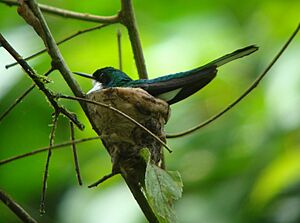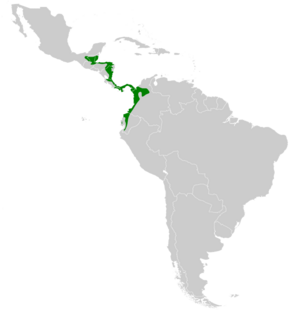Purple-crowned fairy facts for kids
Quick facts for kids Purple-crowned fairy |
|
|---|---|
 |
|
| Purple-crowned Fairy on nest at La Selva Biological Station, outside Puerto Viejo de Sarapiquí in Costa Rica | |
| Conservation status | |
| Scientific classification | |
| Genus: |
Heliothryx
|
| Species: |
barroti
|
 |
|
The purple-crowned fairy (Heliothryx barroti) is a beautiful hummingbird known for its bright colors. It belongs to a group of hummingbirds called "mangoes." You can find this bird in many places, from southeastern Mexico all the way south to northern Peru.
Contents
About the Purple-Crowned Fairy
The purple-crowned fairy was first described in 1843. It was given the name Trochilus Barroti back then. For a while, some experts thought it was the same species as the black-eared fairy. However, scientists now know they are two different, but very closely related, species. These two birds are the only ones in their group, called Heliothryx.
Naming the Bird
The scientific name of the purple-crowned fairy, barroti, honors Adolphe Barrot. He was a French diplomat who worked in Colombia from 1831 to 1835. This bird is considered "monotypic," which means it does not have any different subspecies or types within its species.
What Does It Look Like?
The purple-crowned fairy is a slender bird, about 9 to 13 centimeters (3.5 to 5 inches) long. It weighs around 5.5 grams (0.2 ounces), which is very light!
- Colors: Its upper body is a bright emerald green. Its belly and chest are pure white.
- Tail: It has a long, pointed tail. The middle feathers are blue-black, and the outer ones are white.
- Face: A black patch goes through its eye. Its beak is short, straight, and black.
Differences Between Males and Females
- Males: Have a shiny, metallic violet color on the front of their head. Behind the eye patch, there's a metallic violet spot, with bright emerald green below it.
- Females: Have a green head. Their face has less black, and they don't have the violet spot or the green below the black that males do.
- Young Birds: Young purple-crowned fairies have brownish-red edges on their upper feathers. Their throat and chest might have a few dark spots.
Where It Lives and Its Home
The purple-crowned fairy lives in a wide area. You can find it from eastern Chiapas and southern Tabasco in Mexico. Its range continues through the Caribbean side of Belize, Guatemala, and Nicaragua. It also lives on both sides of Costa Rica and most of Panama. Further south, it's found on the Pacific side of Colombia, Ecuador, and the very northern part of Peru.
Elevation and Habitat
This bird lives from sea level up to different heights depending on the country:
- Up to 500 meters (1,600 feet) in Mexico and northern Central America.
- Up to 1,675 meters (5,495 feet) in Costa Rica.
- Up to 1,000 meters (3,300 feet) in Colombia.
- Up to 800 meters (2,600 feet) in Ecuador.
It prefers to live in the tops of trees and at the edges of wet lowland forests. It also likes shady farms and older secondary forest (forest that has grown back after being cut down).
Behavior
Movement
The purple-crowned fairy does not migrate. It stays in the same areas throughout the year.
Feeding Habits
This hummingbird usually looks for food in the middle and upper parts of the forest. However, at the edges of the forest, it might fly lower.
- Nectar: It drinks nectar from many different flowering plants. It can either put its beak into the flower or pierce the base of the flower to "steal" nectar.
- Insects: It also eats small arthropods, especially spiders. It catches them by hovering and picking them off leaves. Unlike many other hummingbirds, it doesn't usually catch insects while flying.
- Territory: Even though it's not very territorial, this bird can be quite aggressive. It will stand up to other hummingbirds that try to attack it.
Reproduction and Life Cycle
In Costa Rica, the purple-crowned fairy usually breeds between October and March. We don't have much information about its breeding times in other places.
- Nest Building: Only the female builds the nest. She also incubates the eggs and takes care of the young birds.
- Nest Type: The nest is a small, cone-shaped cup made of soft plant material. It doesn't have the lichens that many other hummingbird nests have.
- Nest Location: The female places the nest near the tip of a thin branch. It's usually 6 to 20 meters (20 to 66 feet) above the ground, often over water.
- Eggs and Young: A female lays two eggs. The eggs hatch after 16 to 17 days. The young birds leave the nest 20 to 24 days after hatching.
Vocalization
The purple-crowned fairy doesn't make a lot of noise. Its call is described as a "high, thin, slightly metallic sssit." It might repeat this sound quickly in a series.
Conservation Status
The IUCN (International Union for Conservation of Nature) has evaluated the purple-crowned fairy. They have listed it as a species of "Least Concern." This means it is not currently in danger of disappearing.
- Population: Its population is estimated to be at least 50,000 individual birds. However, this number is thought to be slowly decreasing.
- Human Impact: Human activities probably don't have a big short-term effect on the purple-crowned fairy.


